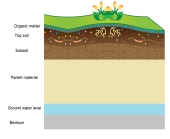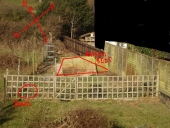
 2
2




 . My name is Victor and I am from The Netherlands. I am living in the Desert in Egypt, 400km south of Caïro. We are starting a permaculture vegetable garden in this arid land, which will be a challenge! I have been reading a lot about permaculture but find it very hard to make a decision on how to start with the first "trial" beds. I would be very grateful if there were people who are willing to share their opinion or experiences on the below matter.
. My name is Victor and I am from The Netherlands. I am living in the Desert in Egypt, 400km south of Caïro. We are starting a permaculture vegetable garden in this arid land, which will be a challenge! I have been reading a lot about permaculture but find it very hard to make a decision on how to start with the first "trial" beds. I would be very grateful if there were people who are willing to share their opinion or experiences on the below matter.
 If you are missing some info please let me know!!
If you are missing some info please let me know!!
 6
6




How Permies works: https://permies.com/wiki/34193/permies-works-links-threads
My projects on Skye: The tree field, Growing and landracing, perennial polycultures, "Don't dream it - be it! "
 2
2




Nancy Reading wrote:Hello Victor and welcome to Permies!
You certainly have a blank sheet when it comes to cultivation there.
You say your aims are to have a vegetable garden there. Is this to feed yourself or to sell/exchange for profit? How reliable is your irrigation/rain?
There are lots of good examples in the greening the desert forum so I would have a good browse in there for techniques that seem to have worked. I also like these two threads from Africa. I know they are not local to you, but both have some really interesting techniques for more arid and hot climates:
elementary school and eco village
Rufaro's market garden thread
I look forwards to seeing your progress.
 3
3




"When the whole world is running towards a cliff, he who is running in the opposite direction appears to have lost his mind." C.S. Lewis
Visit https://themaineingredient.com for organic, premium dried culinary herbs that are grown, processed, and packaged in the USA.
 3
3




Invasive plants are Earth's way of insisting we notice her medicines. Stephen Herrod Buhner
Everyone learns what works by learning what doesn't work. Stephen Herrod Buhner
 1
1




Creating edible biodiversity and embracing everlasting abundance.




In modern times the only right way forward is to come back to nature.
 1
1




 1
1




Matt McSpadden wrote:Hi Victor,
Welcome to Permies!
I don't have any experience with your climate as mine is fairly cold and wet in comparison. However, I would suggest that maybe you look into some kind of livestock. I know you say the dream/plan is for larger scale vegetable production, but livestock can compliment vegetable production in so many ways. Not to mention, it can provide a second source of income, so all your eggs are not in one basket.
 1
1




See Hes wrote:Just as my 5 cents:
You say you have unlimited water due to a deep well.
This is not right, you will be taking part of the overall existing groundwater depletion because you might end up to go deeper and deeper to get water.
This means you take the chance for your trees to raise the groundwater table forever.
The rest of your project is a fantastic idea and challenging.
Veggies, you could grow everything in Greenhouses with evaporation cooling and solar energy.
Check Aquaponics, instead of investing in fertilizer you have fish who does this job.
Even the fish will not be profit but you can breaking even and grow your veggies for free. (2nd class or unsellable veggies are fish feed as well - Tilapias)
In public are many characters who green the desert, just see what Geoff Lawton did or see why (nowadays domestic) animals an essential role playing, when it comes to re greening the desert is Allan Savory another Name to look after...
the best of luck with your project..
 1
1








Victor van Dalen wrote:We are thinking to apply the method with sunken beds described on this page:
https://treeyopermacultureedu.com/chapter-9-earth-working-and-earth-resources/sunken-beds/
Any thoughts on this?
 1
1




Many things last lifetimes or eons, but the only thing that's permanent is the ever-changing flow itself
 1
1




 1
1




'What we do now echoes in eternity.' Marcus Aurelius
How Permies Works Dr. Redhawk's Epic Soil Series




Abraham Palma wrote:
Victor van Dalen wrote:We are thinking to apply the method with sunken beds described on this page:
https://treeyopermacultureedu.com/chapter-9-earth-working-and-earth-resources/sunken-beds/
Any thoughts on this?
I am trying them.
https://permies.com/t/175744/permaculture-sites/permaculture-projects/Project-Gardens-Orchard-Dignity
Beware I barely can irrigate. It has helped us a little, I'd say it extends water like a 30-40% more. Still not enough to stand against a scorching sun and a persistent draught with high temperatures. We need to stack more measures.
 1
1




Victor van Dalen wrote:Hi Abraham,
Thank you for your reply. And did you do the exact design like described in the article? How deep did you dug? And did you add compost?
In the article is mentioned that he waited to plant at least 6 months. Did you do this as well?
Thanks!!

|
and POOF! You're gone! But look, this tiny ad is still here:
Rocket Mass Heater Resources Wiki
https://permies.com/w/rmh-resources
|







